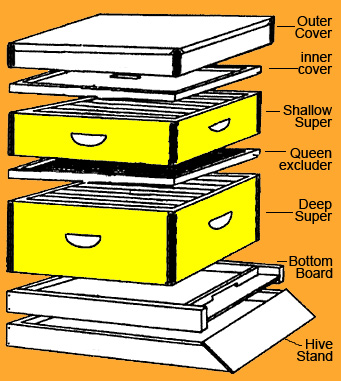All modern beehives are based on the Langstroth hive, named after Reverend LL Langstroth, a 19th century beekeeper. He discovered the idea of ‘bee space.’ If a space is left within the beehive of between 1/4 and 3/8 inch, it is large enough to allow the bees to pass back to back, and it will remain untouched by the bees. Any smaller and the bees will fill it with propolis, any larger and they will fill it with comb.
Using this idea, Langstroth patented the first moveable frame hive. Without the correct bee space, moveable frames were not possible, as the bees would ‘glue’ them together, making them immovable.
The basic Langstroth type hive is shown below (image courtesy of Beehives.info).

Modern beehive components
The components of the Langstroth beehive (from the bottom up) are as follows.
Hive stand
The stand which keeps the hive off the ground, to stop any dampness getting into the hive. Bees can handle cold, but they cannot tolerate dampness.
Bottom board
This is a wooden stand which the hive rests on. This also includes the entrance for the bees to get into (and out of) the hive.
Deep super
Also known as the hive body or the brood chamber, this is where the queen lays all her eggs and all the bees are reared. Some honey and pollen is also stored here for the bees own use, but most of the comb is filled with brood.
Queen excluder
This has openings large enough to allow the smaller worker bees to pass through, but too small for the larger queen. This means that the queen is confined to the brood box and will lay all her eggs in it, so the shallow supers are used only to store honey.
Shallow super
These are the boxes containing the moveable frames of comb where the bees store the honey. The frames can be wired or unwired, and come with a wax foundation, which the bees then draw out with honeycomb.
Inner cover
This provides extra insulation, and prevents the bees from attaching comb to the outer cover.
Outer cover
A lid to provide protection from the elements.
The exception to this basic design is the top bar hive, which has no frames (just ‘top bars,’ hence the name) but they do still use the idea of bee space, and the bars (with comb attached) are moveable.
Langstroth’s ideas radically changed the face of beekeeping, and it is not without reason that he is considered the “father of American beekeeping.”

2 comments
I want to start a beekeeping project on my farm to sustain our orphan and vulnerable children project, and need assistance.
thanks in advance
frans
Hi Frans
Bees For Development is a charity which specifically helps promote beekeeping in developing countries – they will be able to give you the sort of assistance you need. Their website is http://www.beesfordevelopment.org
Hope this helps.